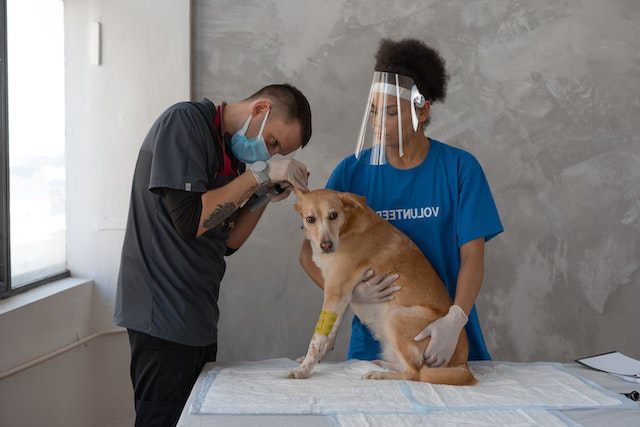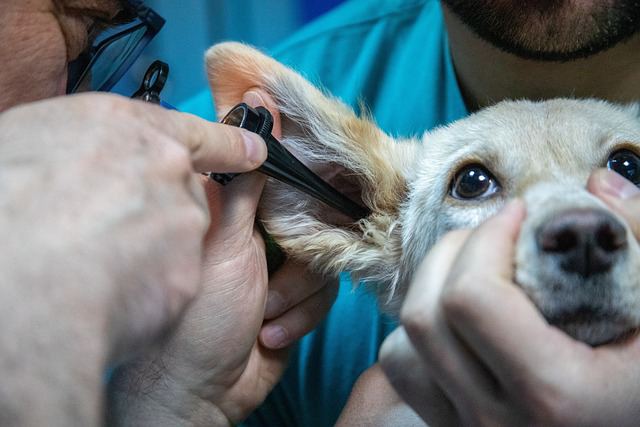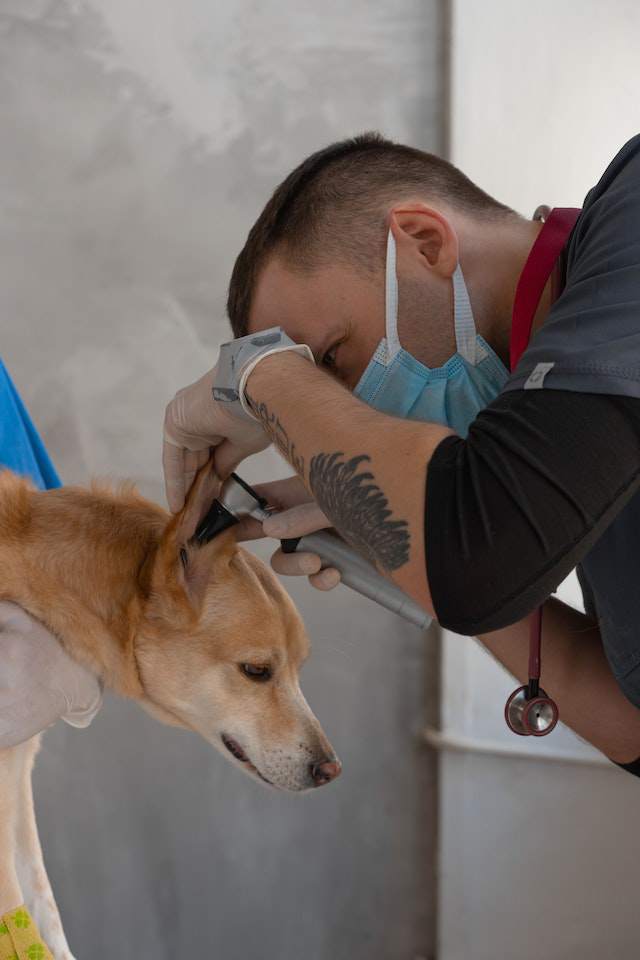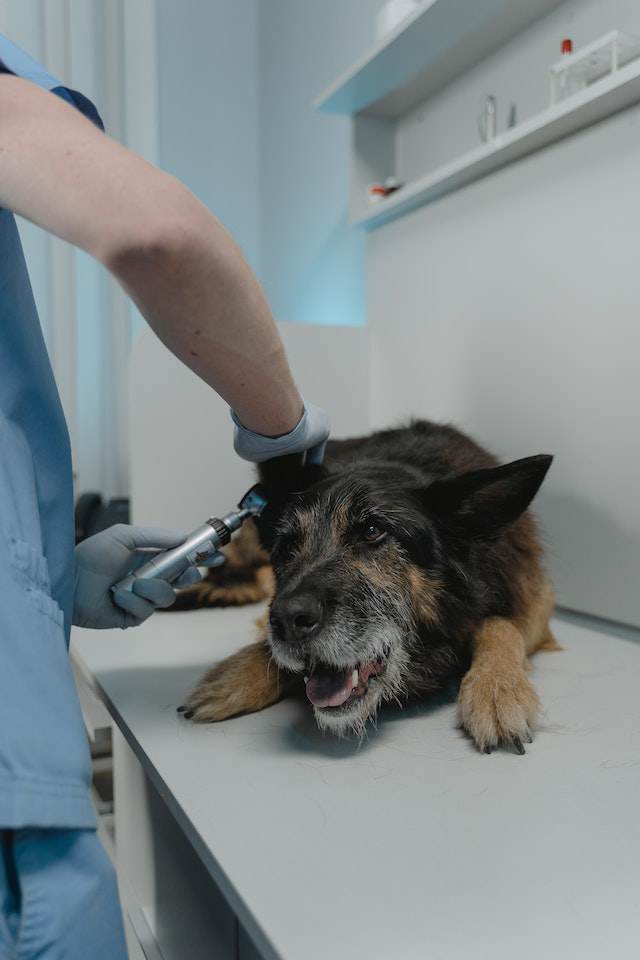10 Most Common Dog Ear Problems With Tips

Hey, fellow dog lovers! If you’ve ever noticed your furry friend scratching their ears incessantly or shaking their head uncontrollably, then this blog post is for you.
We’re diving deep into the world of dog ear problems, uncovering the common causes, symptoms, and most importantly, how to keep those adorable ears healthy and happy.
Signs of Ear Problems in Dogs

Ear problems in dogs can manifest in various ways, and it’s important for dog owners to be aware of the signs that can indicate an issue.
Here are some common signs of ear problems in dogs:
- Scratching or rubbing the ears: Excessive scratching or rubbing of the ears can be a sign that your dog is experiencing discomfort or irritation in the ear.
- Head shaking: Dogs with ear problems often shake their heads vigorously in an attempt to relieve the discomfort. This can be a frequent and noticeable behavior.
- Ear odor: An unpleasant odor emanating from your dog’s ears can be indicative of an infection or other ear problem.
- Redness or swelling: Inflamed or swollen ears can be a sign of an underlying issue, such as an infection or allergic reaction.
- Discharge: If you notice any discharge coming from your dog’s ears, it could be a sign of infection or inflammation.
- Pain or sensitivity: Dogs with ear problems may exhibit signs of pain or discomfort when their ears are touched or manipulated.
- Changes in behavior: Ear problems can cause dogs to exhibit changes in behavior, such as increased irritability or reluctance to be touched.
- Loss of balance: In some cases, ear problems can affect a dog’s balance and coordination. This can manifest as stumbling, falling, or walking in circles.
- Changes in hearing: Dogs with ear problems may experience hearing loss or a decrease in their ability to respond to auditory cues.
It’s important to note that these signs can vary depending on the specific ear problem your dog is experiencing.
If you notice any of these signs, it’s recommended to consult with a veterinarian for a proper diagnosis and appropriate treatment.
Most Common Dog Ear Problems
The following are some of the most common dog ear problems with tips:
1. Ear Infections
Ear infections are a common problem in dogs, typically caused by bacteria or yeast. The primary causes include allergies, excessive moisture in the ear, or underlying health conditions.
To prevent ear infections in dogs, it is crucial to keep your dog’s ears clean and dry, especially after swimming or bathing. Regular ear inspections and cleaning can help identify and address early signs of infection.
Treatment often involves cleaning the ear canal and administering prescribed medications, such as antibiotics or antifungal drugs, as directed by a veterinarian.
2. Ear Mites
Ear mites are a common dog ear problem caused by tiny parasitic mites that infest the ear canal. The most common cause of ear mite infestation is direct contact with an infected animal.
To prevent ear mite infestations, it is essential to keep your dog away from infected animals and maintain good hygiene. Regular ear cleanings can help remove any ear mites and reduce the risk of infestation.
Treatment typically involves using prescribed medications like ear drops or topical solutions to eliminate the mites and soothe any irritation.
3. Wax Buildup
Wax buildup in a dog’s ears can be a common problem that may lead to discomfort and potential infections. The main causes of wax buildup include excessive production of ear wax, allergies, and ear mites.
To prevent wax buildup, regular ear cleaning should be incorporated into the dog’s grooming routine.
Treatment for wax buildup involves gently cleaning the ears with a veterinarian-recommended ear cleaner and possibly using ear drops or medication prescribed by a vet.
4. Allergies
Allergies can be a common problem in dogs, affecting their ears. Causes of ear allergies in dogs may include environmental allergens such as pollen, dust mites, or mold, as well as food allergies.
Prevention involves minimizing exposure to allergens, keeping the dog’s environment clean, and providing a balanced diet.
Treatment typically involves identifying and avoiding the allergen, using ear cleansers to remove excess debris, and administering medications such as antihistamines or corticosteroids as prescribed by a veterinarian.
5. Ear Tumors
Ear tumors in dogs are abnormal growths that develop in the ear canal or on the ear flap. They can be categorized as benign or malignant, with the latter being more concerning.
The exact causes of ear tumors in dogs are not well understood, but certain factors like chronic ear infections, exposure to sunlight, and genetic predisposition may play a role.
Preventative measures include regular ear cleaning, avoiding excessive sun exposure, and prompt treatment of ear infections.
Treatment options for ear tumors in dogs may include surgical removal, radiation therapy, or chemotherapy, depending on the type, size, and location of the tumor.
6. Hematoma
Hematoma in dogs’ ears is a condition characterized by the accumulation of blood between the skin and cartilage of the ear.
It is commonly caused by trauma or excessive shaking of the head. Prevention involves addressing the underlying cause, such as treating ear infections or preventing vigorous shaking.
Treatment options include draining the hematoma, administering medication to reduce inflammation and pain, and in severe cases, surgical intervention.
Timely diagnosis and intervention are crucial to prevent complications and promote a speedy recovery.
7. Ear Trauma
Ear trauma in dogs can occur due to various causes, including blunt force trauma, foreign objects, excessive scratching, or dog fights.
Prevention involves keeping dogs away from hazardous environments and ensuring their living spaces are free from sharp objects.
Treatment for ear trauma may involve cleaning the wound, removing any foreign objects, and administering antibiotics to prevent infection.
In severe cases, surgical intervention may be necessary. Regular inspections of the dog’s ears and prompt veterinary attention can help prevent and manage ear trauma effectively.
8. Deafness
Deafness in dogs can be a result of various factors, including genetic predisposition, certain medications, infections, trauma, or aging.
Prevention strategies include responsible breeding practices to avoid passing on genetic conditions, minimizing exposure to loud noises, and regular veterinary check-ups to catch any potential issues early.
Treatment options for deaf dogs mainly focus on training and communication techniques that rely on visual cues, such as hand signals or vibrations. In some cases, hearing aids or cochlear implants may be considered as well.
Ultimately, it is important for dog owners to provide a supportive and understanding environment for their deaf pets, allowing them to lead happy and fulfilling lives.
9. Ear Canal Obstruction
Ear canal obstruction is a common problem in dogs that can cause discomfort and potential complications.
The main causes of ear canal obstruction in dogs include excessive ear wax buildup, foreign objects, and ear mites.
Prevention involves regular ear cleaning and inspection, especially for dogs with floppy ears or a history of ear problems.
Treatment options for ear canal obstruction may include ear flushing, removal of foreign objects, medication for ear mites, and in severe cases, surgical intervention.
10. Ear Cancer
Ear cancer in dogs, also known as canine aural squamous cell carcinoma, is a relatively rare but serious condition.
The main cause of ear cancer in dogs is prolonged exposure to ultraviolet (UV) radiation, which can be exacerbated by light-colored ears and excessive sun exposure.
Preventive measures include limiting sun exposure, using pet-safe sunscreen, and providing shade. Treatment options for ear cancer in dogs may include surgery, radiation therapy, and chemotherapy.
Early detection is crucial for a better prognosis, so regular ear examinations and prompt veterinary attention are essential.
Diagnosis of Ear Problems in Dogs

Diagnosing ear problems in dogs involves a thorough examination of the external ear canal, ear drum, and surrounding tissues.
The veterinarian will inspect for signs of inflammation, redness, discharge, odor, and swelling.
A swab may be taken to examine under a microscope for the presence of bacteria, yeast, or parasites.
In some cases, a culture and sensitivity test may be performed to identify the specific microorganism causing the infection and determine the most effective treatment.
The veterinarian may also recommend additional tests such as blood work or imaging if there are concerns about underlying conditions contributing to the ear problem.
Treatment Options for Dog Ear Problems
When it comes to treating dog ear problems, the specific treatment options will depend on the underlying cause of the issue. Here are some common treatment options for dog ear problems:
1. Medications: In many cases, dog ear problems can be treated with medications. These may include antibiotics to treat bacterial infections, antifungal medications for fungal infections, and corticosteroids to reduce inflammation and itching. Ear drops or ointments may be prescribed to apply directly into the ear canal.
2. Cleaning the ears: Regular ear cleaning is an important part of preventing and treating dog ear problems. This involves gently cleaning the ear canal to remove debris, excess wax, and any buildup that may contribute to infections. It’s important to use an appropriate cleaning solution and follow the instructions provided by your veterinarian.
3. Dietary changes: In some cases, dog ear problems may be linked to food allergies or sensitivities. Your veterinarian may recommend a change in your dog’s diet to help alleviate the issue. This may involve switching to a hypoallergenic or limited-ingredient diet.
4. Ear flushing or irrigation: In certain situations, your veterinarian may perform ear flushing or irrigation to help remove debris, pus, or excess wax from the ear canal. This can be done using a specialized solution and equipment.
5. Surgery: In more severe cases or when other treatment options have been unsuccessful, surgery may be necessary. This can include procedures like Total Ear Canal Ablation (TECA), which involves removing the entire ear canal to address chronic ear infections or other serious conditions.
It’s important to note that the appropriate treatment option for your dog’s ear problem will depend on the specific diagnosis made by your veterinarian.
It’s always best to consult with a veterinary professional to determine the most suitable course of action for your dog’s individual needs.
Ways of Preventing Ear Problems in Dogs

Ear problems are common in dogs and can cause discomfort and pain. Fortunately, there are several ways to prevent ear problems in dogs.
Here are some common preventive measures:
1. Regular Cleaning: Regularly cleaning your dog’s ears can help remove debris and excess wax, and prevent the buildup of bacteria and yeast. Use a veterinarian-recommended ear-cleaning solution and follow the instructions carefully.
2. Avoid Moisture: Keep your dog’s ears dry, as moisture can create an environment for bacteria and yeast to thrive. After swimming or bathing, dry your dog’s ears thoroughly using a clean towel.
3. Proper Grooming: Regular grooming can help prevent ear problems. Trim excess hair around the ear canal, as it can trap moisture and debris. Consult a professional groomer for assistance if needed.
4. Avoid Irritants: Avoid exposing your dog’s ears to irritants such as harsh chemicals, cleaning products, or excessive ear scratching. These can lead to inflammation and ear problems.
5. Regular Check-ups: Schedule regular check-ups with your veterinarian to monitor your dog’s ear health. Your vet can examine the ears, identify any early signs of infection or inflammation, and provide appropriate treatment if necessary.
6. Balanced Diet: A balanced and nutritious diet plays a crucial role in maintaining overall health, including ear health. Consult your veterinarian for recommendations on a suitable diet for your dog’s specific needs.
7. Allergen Management: Identify and manage any allergens that may trigger ear problems in your dog. Common allergens include pollen, dust mites, certain foods, or environmental factors. Consult with your veterinarian for guidance on allergy management.
8. Regular Exercise: Regular exercise helps improve your dog’s immune system and overall health, which can contribute to preventing ear problems. Ensure your dog gets enough exercise to maintain a healthy lifestyle.
9. Avoid Self-medication: It’s important to avoid self-medicating your dog’s ear problems. Using over-the-counter products without proper diagnosis and guidance from a veterinarian can worsen the condition or mask underlying issues.
Remember, prevention is key when it comes to ear problems in dogs. By following these preventive measures and seeking veterinary care when necessary, you can help keep your dog’s ears healthy and free from problems.
Related Questions
Can allergies cause ear problems in dogs?
Yes, allergies can contribute to ear problems in dogs. Allergic reactions can lead to inflammation and excessive wax production, making the ear more susceptible to infections. If your dog has recurring ear problems, it’s important to identify and manage any underlying allergies.
Are certain dog breeds more prone to ear problems?
Yes, some breeds are more susceptible to ear problems due to their ear anatomy. Dogs with floppy ears, like Cocker Spaniels or Basset Hounds, are more prone to ear infections as their ears can trap moisture and debris. However, ear problems can occur in any breed, so regular ear care is important for all dogs.
Can I use over-the-counter products to treat my dog’s ear problems?
It’s generally recommended to consult with a veterinarian before using any over-the-counter products. While some products can be effective for mild cases, others may worsen the condition or cause adverse reactions. A proper diagnosis by a vet will ensure the most appropriate treatment for your dog’s specific ear problem.
When should I take my dog to the vet for ear problems?
It’s advisable to consult a veterinarian if you notice persistent or severe symptoms, such as intense itching, discharge, or swelling, or if your dog appears to be in pain. Additionally, if home remedies or over-the-counter treatments don’t improve the condition within a few days, it’s best to seek professional veterinary care to prevent the problem from worsening.
Conclusion
In conclusion, taking care of your furry friend’s ears is crucial for their overall health and well-being.
By being proactive and regularly checking for any signs of ear problems, you can prevent discomfort and potential complications down the line.
Remember, a happy pup with healthy ears is a happy home!
